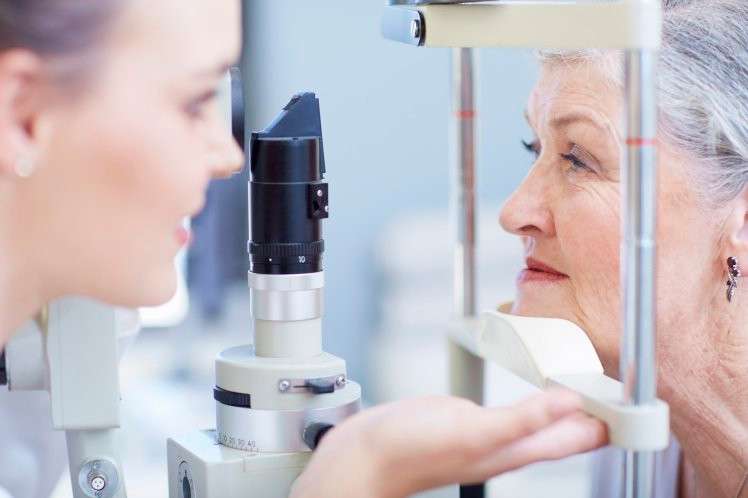The visually impaired first regained vision with skin cell transplants
Japanese scientists have just announced the successful transplants of human skin cells, opening hope for many blind people around the world.
The patient is a 70-year-old woman, diagnosed with an age-related macular degeneration or also known as AMD . AMD is the main cause of blindness in people over 50 years of age. The patient was tested in 2014 as part of the preliminary study and two years after the transplant was performed, scientists began to share their results.
The researchers performed the implant by taking a small piece of skin on the patient's arm (4mm diameter) and altering its cells, then they re-established these cells to turn them into Multi-purpose stem cells , called iPSC for short .
Pluripotent stem cells have the ability to differentiate into almost any type of tissue in the body, which is why skin cells taken from the arm can be reused for retinal tissue.

Scientists hope to quickly apply this treatment to more patients.(Photo: Getty Images / Metro.co.uk).
When cells are reared to develop retinal pigment epithelium (RPE) , ie retina insulating layer with the vascular layer behind the retina, RPE is cultured in the laboratory for delivery. developed into an ultra-thin plate and used to implant the back of the patient's retina.
Speaking at the 2014 press conference, team leader Masayo Takahashi of Riken Development Biology Center said: "I am very pleased that there are no complications when transplant surgery. However, this is only is the first step in the use of iPSC cells in regenerative medicine, I will try my best in the lead until this treatment can be applied to all patients ". "This is a result of long-term efforts. Accordingly, the group made a step forward in a short period of about seven years from when iPS cells were created. I want to express my admiration for the group".
It is still very early to talk about the certainty of this experiment. However, good signs have so far been promising for patients. The team has moved the time to report results so far to monitor how patients progress and how long the success of the successful cells changes. They have also reported that transplanted cells survived without any side effects for more than a year, resulting in improved visual acuity of patients.
"The transplanted RPE membranes survived well without any signs or signs of immune rejection or unwanted disadvantages within," the team said in a statement this week. Over the past year and a half, we have achieved the main purpose of this preliminary study ".

The researchers performed the implant by taking a small piece of skin on the patient's arm.
The patient expressed to the Japanese Times that she was happy to be treated with this method and felt her eyes light up and her vision was expanded very well.
This method does not fully restore the patient's eyesight, but the study has shown a significant step forward in the use of induction-based multipurpose stem cells. Scientists believe that iPSC can be used not only to treat vision-related problems, but also a host of other diseases such as Alzheimer's and Parkinson's.
A variety of other studies are also leading to positive results in visual recovery with stem cell treatments. Earlier this year researchers in China and the United States also found a way to improve the sight of cataract babies by adjusting protein levels in stem cells. More notably, a woman in Baltimore, USA, who was blind for more than five years recovered her sight by using bone marrow-derived stem cells then injected into her eyes. Many questions have been raised about this particular treatment. However, it is undeniable that the study of stem cells is an extremely interesting field in scientific research.
* These results were presented at the United States annual meeting of the Vision and Vision Research Association (ARVO), the Association for Research in Vision and Ophthalmology.
- Transplant cells to help visually impaired people recover vision?
- Russia makes navigation devices for the visually impaired
- 3D print map for visually impaired people
- The application helps blind people read menus, find directions
- 3D print technology can help the visually impaired to access art
- Touchscreen for the visually impaired
- Aids to help blind people ride their bicycles
- The film is thinner than the hair, which helps blind people regain their sight
- Blind eyesight - The strangest state of awareness
- There has been a way to help people with brain injury regain their eyesight
- 'New' eyes for the visually impaired
- Smoked menus for the visually impaired
 Green tea cleans teeth better than mouthwash?
Green tea cleans teeth better than mouthwash? Death kiss: This is why you should not let anyone kiss your baby's lips
Death kiss: This is why you should not let anyone kiss your baby's lips What is salmonellosis?
What is salmonellosis? Caution should be exercised when using aloe vera through eating and drinking
Caution should be exercised when using aloe vera through eating and drinking